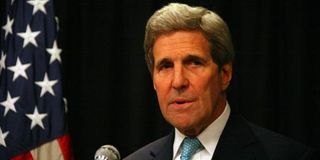Dadaab to remain open, says John Kerry

US Secretary of State John Kerry addresses a press conference at the Sankara Hotel in Nairobi on May 4, 2015. PHOTO | EVANS HABIL |
What you need to know:
- US to give $45 million for refugee programmes in Kenya.
- DP Ruto had called for Dadaab to be closed.
The United States has asked Kenya not to close the Dadaab Refugee Camp because the “fundamental problems” in Somalia are still unresolved.
On Monday evening, US Secretary of State John Kerry announced an additional Sh4 billion ($45 million) for refugees programmes in Kenya, but asked the government to help stabilise Somalia first before refugees can return.
“I know some people here feel it is a burden… it is completely understandable; but on the other hand it shows that Kenya has accepted people who are running away from terror in their countries.
“The key is to accelerate efforts to have a plan in place for the ability of refugees, not just in Dadaab but in all refugee camps, to be able to return home in a voluntary manner in dignity and safety,” he told a news conference in Nairobi.
Mr Kerry’s comments was a response to a directive issued last month when Deputy President William Ruto told the UN refugee agency UNHCR relocate refugees to Somalia in 90 days.
The directive was contested by both aid and human rights organisations, citing continual violence in Somalia and violation of international laws. Mounting pressure led the government to announce that the relocation would only happen in collaboration with UNHCR and the Somalia government.
However, the government insisted that Mr Ruto’s announcement would remain the “bottom line”.
REMAIN OPEN
On Monday, Mr Kerry said he had discussed the issue with President Uhuru Kenyatta who he argued had “agreed” for the need to stabilise Somalia first. The diplomat also met with UNHCR officials and spoke to some of the Dadaab refugees via Skype.
“I am confident that Dadaab will remain open while we work through a plan on how people will be able to go home, by doing our job and finishing our task in Somalia and in South Sudan.
“What the pressure of the refugee situation is doing is reminding everybody of the need to accelerate efforts to solve the underlying fundamental problems so people can go back to their homes in peace,” Mr Kerry said.
He was referring to the ongoing African Union Mission in Somalia (Amisom) of which the Kenya Defence Forces are part. The Mission is expected to stabilise Somalia and is supported financially by the European Union and the US.
Although there has been debate in Kenya over whether troops should pull out, Mr Kerry argued Kenya “is a leader of the team” and its troops should remain in Somalia.
“Kenya will be safer if Somalia is stable, Kenya should be proud. Obviously they (Kenyans) want an end to it and we all want an end to it, but one thing I have learnt is that Amisom needs a boost,” he argued.
“I do hope that Kenyans can be little patient… and I think the exit strategy needs to be a success.”
CONTINUED ATTACKS
The debate on troops has been influenced by continued attacks by Al-Shabaab on Kenyan soil. For example, despite KDF capturing Kismayu in September 2012, there have been more than 130 attacks in Kenya.
But government officials have claimed that terrorists are being harboured in Dadaab. The camp, which at one time hosted up to 450,000 refugees, has been in existence since 1991 when the Somali government collapsed.
On Monday, Mr Kerry said Kenya should concentrate on stabilising Somalia and strengthening counter-terrorism mechanisms as a better way at helping refugees return home.
“Refugee camps are supposed to be temporary, not permanent cities in foreign countries,” he said.
Dadaab currently hosts up to 335,000 refugees — larger than the population of Nakuru town — with most from Somalia but others are from DR Congo and Ethiopia.
Kakuma Refugee Camp in Turkana County ,on the other hand, hosts refugees mainly from South Sudan which has been experiencing violence since 2013.





